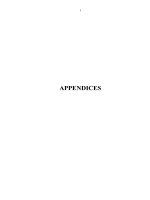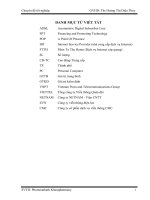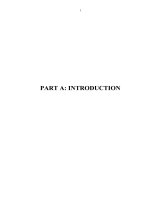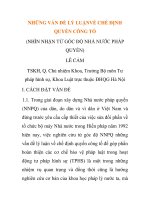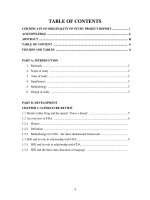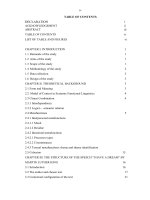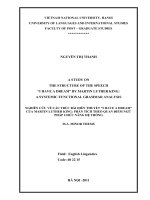PHÂN TÍCH bài DIỄN văn của MARTIN LUTHER KING ‘BEYOND VIETNAM – a TIME TO BREAK SILENCE’ từ góc độ PHÂN TÍCH DIỄN NGÔN PHÊ PHÁN
Bạn đang xem bản rút gọn của tài liệu. Xem và tải ngay bản đầy đủ của tài liệu tại đây (369.47 KB, 79 trang )
PART A: INTRODUCTION
1
1. Rationale
There has been much written in recent years about Critical Discourse Analysis (CDA for
short). It appears to be quite difficult to define CDA in simple terms. However, CDA is my
choice for the MA thesis because first and foremost, CDA regards language as a social
practice – language is a part of society, language is a social process, and language is a
socially conditioned process. These implications have been discussed in details by Norman
Fairclough (1989).
Then, it can be inferred from above implications that doing discourse analysis involves in
not merely analyzing texts, processes of production and interpretation, but also analyzing
the relationship between texts, processes, and their social conditions – or in other terms,
the relationship between texts, interactions, and contexts. And CDA is critical in the sense
that it shows connections and causes which are hidden – such as the connection between
language, power and ideology, the problems of inequality and racism – through discourse
analysis. More clearly stated, CDA is critical when it explicitly addresses social problems
and seeks to solve social problems through the analysis and accompanying social and
political action. The intention of the analysts in this view of ‘critical’ is explicitly oriented
toward locating social problems and analyzing how discourse operates to construct and
historically constructed by such issues. They must work from the analysis of texts to the
social and political context in which the texts emerge. CDA thus can be said a very
practical form of discourse analysis. It seeks not only to describe language but also to offer
critical resources to those wishing to resist various forms of power.
For those mentioned reasons, a speech by Martin Luther King “Beyond Vietnam – A Time
to Break Silence” is to be analyzed from the CAD viewpoint together with the hope that
this study may vice versa help illustrate and clarify CDA concepts. Despite being delivered
in 1967, this speech was especially mentioned by many Americans when the U.S.
government decided to attack Iraq in 2003. It is the ideological and topical features of this
speech that “Beyond Vietnam – A Time to Break Silence” by Martin Luther King has been
chosen. During the course of analyzing the speech, the way power and ideology embedded
in texts and coded in language use will be gradually manifested. Although I am a supporter
of Martin Luther King, I will try to be objective towards political issues in the speech – a
crucial demand in CDA – as a base for critical reading of any text and developing scientific
and objective standpoint towards any discourse where power relations may exist.
2
Another reason for choosing CDA comes from my own personal interest. In general, when
any theory or approach in linguistics appears, it will be studied and, through researches,
practically applied to teaching and leaning. CDA has shown its role in social sciences, but I
am really interested in the fact that whether CDA viewpoint is of some help in language
teaching and learning. I hope to find the answer during the application of CDA approach in
the analysis of the speech “Beyond Vietnam – A Time to Break Silence” by Martin Luther
King.
2. Scope of the study
The analysis of Martin Luther King’s speech is confined to verbal aspects of the speech
and the social context when the speech was delivered. Because of some reasons,
paralinguistic (intonation, speed, loudness, etc.) and extralinguistic (facial expression, eye
contact, etc.) factors are not taken into account though they are important in the discourse.
This is a pure linguistic study and for academic purpose only. I will not express my own
political view. And this study is not for or against any party or to change anyone’s political
viewpoint.
3. Objectives and aims of the study
The objectives of the study in analyzing Martin Luther King’s speech “Beyond Vietnam –
A Time to Break Silence” from CDA standpoint include:
- Providing a theoretical background of CDA – its concepts, its analysis procedures
as well as its role in social scientific research and in general in linguistics in
particular.
- Finding out hidden power/struggle and ideology from linguistic elements of the
text. In order to realize this aim, the study is supposed to answer the following
research questions:
• How are power and ideology realized lexically and
grammatically?
• How are power and ideology realized in terms of transitivity
and thematic structures?
• How are power and ideology realized macro structurally?
3
Besides, this study also aims at:
- Providing an objective view as a linguist when approaching texts, especially those
addressing power and ideology.
- Trying to develop the ability in critical thinking.
- Finding the application of CAD approach in language teaching and learning.
4. Design of the study
The study consists of three parts. They are:
Part A: Introduction: This part presents the rationale, scope, aims, methodology, and
design of the study.
Part B: Development: This is the main part and it consists of three chapters.
Chapter 1: Theoretical background.
This chapter gives an overview of CDA – its history, role, concepts, and procedure.
Systemic-functional theory is also concerned in this chapter.
Chapter 2: A critical discourse analysis of Martin Luther King’s speech: ‘Beyond
Vietnam – A Time to Break Silence’.
The CDA procedure addressed by Fairclough and systemic-functional theory are applied to
analyze the speech to find out the connection between power/struggle, ideology and the
language.
Chapter 3: Implications
Some implications of applying CDA in developing critical thinking, in language teaching
and learning.
Part C: Conclusion
This part summarizes the main findings of the study, draws important conclusion and
offers suggestions for further research.
References
Appendices
4
5. Methodology
To carry out this study, the following procedures and techniques involving both qualitative
and quantitative research method will be employed.
Approach
CDA as an approach will be applied in the speech analysis to uncover hidden
power/struggle and ideology. The three stages of CDA given by Norman Fairclough
(2001) will be used. The three stages are the text analysis, interpretation and explanation.
To put it more specifically, following are techniques involving in the analysis.
Techniques
In terms of data collection, number of books and articles about CDA will be collected and
thoroughly studied so that I can build the theoretical background of CDA for the anlysis.
There may be of course different viewpoints of CDA, so I will read and take those that are
most suitable for my analysis of the speech. Besides, as suggested by Norman Fairclough
in his paper (1991) in Discourse & Society : ‘Systemic-functional linguistics also has a
view of texts which is a potentially powerful basis not only for analysis of what is in texts,
but also for analysis of what is absent or omitted from texts”, Halliday’s functional
grammar is also my focus. Besides, documents for a panorama of the social context are
also needed.
In terms of text analysis, the linguistic features (lexicology and grammar) of the text will
be described to see how power/struggle and ideological position of the speaker are encoded
in the text. I will analyze vocabulary with attention to formal words, classification
schemes, synonyms and antonyms. Then, as suggested by Fairclough (2001), grammar
features will be analyzed including personal pronoun, voice, modes of the sentence,
modality and connective values of the text.
Apart from that, the text is also analyzed in terms of transitivity, thematization, and
macrostructure. I will look at the dominant processes in clauses of the speech how
ideology and power are hidden in transitivity. The text will be also broken into information
units (Halliday, 1994) so that I can identify them theme and rheme in sentence structure to
interpret their structural role in the introduction of new information. Regarding
macrostructure or overall idea of the speech, the text will be divided into major sections
and then four procedures namely attributive deletion, predictive deletion, simple
5
generalization, and integration suggested by Van Dijk (1977, 144-146) will be applied. In
this part, my aim is to uncover power and ideology hidden behind words.
The next step is interpreting the relationship between the processes of text production and
interpretation. There are two domains here: interpretation of situation context and
interpretation of intertextual context. In the interpretation of situation, I follow questions
given by Fairclough (2001): what’s going on, who’s involve, what relationships are at
issue, and what’s the role of language. In interpretation of intertextual context,
presuppositions are in focus.
And then, explanation concerned with the relationship between those processes and social
context – how the discourse change or sustain certain social relationship in social structure
– is needed. The speech will be looked at as a social practice in relation with other social
practices.
Finally, implications will deduced from my understanding in CDA, in language teaching
and learning methodologies as well as my own experience.
6. Significance
Theoretically, this study provides a support to CDA theories. From an objective view as a
linguist when approaching texts, CDA analysts can find out ideology and power hidden
behind words. Practically, this study is submitted in partial fulfillment of requirements of
my degree of Master in Linguistics. Moreover, it may provide me another approach to
language teaching and learning: looking at language teaching and learning from CDA
viewpoint.
6
PART B: DEVELOPMENT
7
Chapter 1:
THEORETICAL BACKGROUND
1.1. An overview of CDA
Critical Discourse Analysis, CDA for short, is a fairly new branch of linguistics. Formerly,
Critical Linguistics and Critical Discourse Analysis were used interchangeably, but in
recent times it seems that the latter is preferred and is used to denote the theory formerly
identified as Critical Discourse.
CDA as a network of scholars appeared in the early 1990s. It is marked by the birth of Van
Dijk’s journal Discourse and Society (1990) as well as through several books, like
Language and Power by Norman Fairclough (1989), Language, Power and Ideology by
Ruth Wodak or Van Dijk’s first book on racism, Prejudice in Discourse (1984). But since
the Amsterdam in January 1991, more researchers have started work with CDA, new
journals have been launched, multiple overview has been written, and nowadays CDA is
an established paradigm in linguistics.
Many of the basic assumptions of CDA that were salient in early stages and elaborated in
later development of the theory are stated in Kress’s work (1989). CDA considers
language as a social phenomenon. Not only individuals, but also institutions and social
groupings have specific meanings and values, that are expressed in language in systematic
ways. In CDA, texts are seen as the relevant units of language in communications, readers
and hearers are not passive recipients in their relationship to texts, and there are similarities
between the language of science and the language of institutions, and so on. However, a
clearer and more general approach to CDA can be found in the work by Fairclough and
Wodak (1997). According to them, CDA regards “language as social practice” and takes
consideration of the context of language use to be crucial.
Language is a social practice means that language is a part of society, language is a social
process, and language is a socially conditioned process. In Fairclough’s point of view
(2001), firstly, language is a part of society in the sense that linguistic phenomena are
8
social phenomena, and vice versa although this relationship is not symmetrical. Whenever
people speak or listen or read or write, they involve in a/some social relationship(s). And
the language they use is not only socially determined by the social relationships but also
affects them in helping to maintain (or change) these relationships. Social phenomena are
linguistic, on the other hand, in the sense that the language activity in social contexts is not
merely a reflection or expression of social processes and practices, it is a part of those
processes and practices. For example, disputes about the meaning of political expressions
are an aspect of politics.
Secondly, language is a social process. Language comes into life in form of texts (the term
Michael Halliday uses for both written and spoken texts). In CDA, text is not discourse.
Text is the product of text production and the resource for the process of interpretation.
During the processes of text production and text interpretation, people have to depend on
what they have in minds – including their knowledge of language, natural and social
worlds, values, beliefs, assumptions and so on. In other terms, text is the traces of the
productive process and cues in the interpretative process. (Fairclough, 2001)
Thirdly, language is a socially conditioned process as the processes of production and
interpretation are socially determined. Text producers and interpreters not only draw upon
what are there in their heads, they are also socially generated and socially transmitted.
People internalize what is socially produced and made available to them and use this to
engage in their social practice, including discourse. To make it clearer, Fairclough (2001)
calls what discourse participants have in their minds during the course of interpreting and
producing texts as Member’s Resources (MR) - resources for productive and interpretative
processes. MR have both cognitive and social features as they come from people’s mind
while they are socially originated.
Thus, when CDA sees language as discourse and as a social practice, apart from analyzing
texts, productive and interpretive processes, the relationship between texts, processes and
their conditions needs to be taken into account. The following figure can be seen as an
illustration of this relationship.
9
Figure 1: Discourse as text, interaction and context
(Fairclough, 2001:21)
However, CDA is made distinguished in terms of “critical”. According to Rogers, R.
(2004), the concept of critical is rooted in the Frankfurt school of critical theory (Adorno,
1973; Adorno & Horkeimer,1972; Habermas, 1976). Critical research and theory is a
rejection of naturalism (that social practices, labels, and programs represent reality),
rationality (the assumption that truth is a result of science and logic), neutrality (the
assumption that truth does not reflect any particular interests), and individualism. Critical
research rejects the overdeterministic view of social theory espoused by Marxists and
instead argues for dialectic between agency and structural determinism. As with all
research, the intentions of critical discourse analysts are not neutral.
Teun A.van Dijk in the paper Multidisciplinary CDA: a plea for diversity (collected by
Wodak, R. and Meyer, M. 2001) considers “CDA as a – critical – perspective on doing
scholarship: it is, so to speak, discourse analysis “with an attitude”. It focuses on social
problems, and especially on the role of discourse in the production and reproduction of
power abuse or domination. Wherever possible, it does so from a perspective that is
consistent with the best interests of dominated groups.
The term critical in CDA is often associated with studying power relations (Fairclough,
1997). In Language and Power (2001), Fairclough mentions “power in discourse” and
“power behind discourse”. In terms of “power in discourse”, discourse is the site of
struggle, and in terms of “power behind discourse”, it is the stake in power struggle – for
control over orders of discourse is a powerful mechanism for sustaining power.
10
Social conditions of production
Social conditions of interpretation
Context
Process of production
Process of interpretation
Interaction
Text
Fairclough (ibid:61) shows three types of constraint which powerful participants in
discourse can exercise over the contributions of non-powerful participants: constraints on
contents (on what it is said or done), constraints on relations ( the social relations people
enter into discourse) and constraints on subject ( subject position people can occupy
according to their social relation and status). When these constraints are thought of in a
relatively ‘structural’ and long-term way as a matter of power behind discourse – that is, a
matter of the conventions of discourse types constraining participants’ contributions in
these three ways – they may have long-term structural effects on an institutions or society.
(Figure 2. Fairclough, 2001,62).
Constraints Structural effects
Contents
Relations
Subjects
Knowledge and beliefs
Social relationships
Social identities
Table 1: Constraints on discourse and structural effects
For CDA, language is not powerful on its own. In fact, it gains power by the use powerful
people make of it. This explains why CDA often chooses the perspective of those who
suffer, and crtically analyses the language use of those in power. “CDA takes the
experiences and opinions of members of such groups seriously, and supports their struggle
against inequality. That is, CDA research combines what perhaps somewhat pompously
used to be called ‘solidarity with the oppressed’ with an attitude of opposition and dissent
against those who abuse text and talk in order to establish, confirm or legitimate their
abuse of power. Unlike much other scholarship, CDA does not deny but explicitly defines
and defends its own sociopolitical position. That is, CDA is biased – and proud of it”
(Teun van Dijk, Multidisciplinary CDA: a plea for diversity collected by Ruth Wodak &
Michael Meyer (Eds.), 2001: 96).
Fairclough and Wodak (1997) offered eight foundational principles of CDA. These
principles are a useful starting point for researchers interested in conducting CDA. They
include:
• CDA addresses social problems
• Power relations are discursive
• Discourse constitutes society and culture
11
• Discourse does ideological work
• Discourse is historical
• A sociocognitive approach is needed to understand how relations between texts and
society are mediated
• Discourse analysis is interpretive and axplanatory and uses a systematic
methodology
• CDA is a socially committed scientific paradigm
(taken from Rogers, R. 2004)
CDA as an approach is of an important role in social scientific research. Researchers who
are interested in the relationship between language and society use CDA to help them
describe, interpret and explain such relationship. CDA is different from other other
discourse analysis methods because it includes not only a description and interpretation of
discourse in context, but also offers an explanation of why and how discourses work.
To put it more specifically, CDA addresses social problems and seeks to solve social
problems through the analysis and accompanying social and political action. The intention
of the critical discourse analysts is locating social problems and analyzing how discourse
operates to construct and is historically constructed by such issues. In this perspective,
analysts believe that analyzing texts for power is not enough to disrupt such discursive
powers. Instead, the analysis must work from the analysis of texts to the social and
political contexts in which the texts emerge.
Before the analysis of texts begins, it is often thought that data collection is the first phase
that must be completed. However, there is no typical CDA way of collecting data, and in
the contributions of Van Dijk and Norman Fairclough, there is no evidence concerning
data collection requirements. In CDA many studies mostly deal with only small corpora
which are usually regarded as being typical of certain discourses. So, to identify
participants and mediational means which are relevant for the research question, doing
surveys may be one suitable way. The surveys should narrow down the scope of the
research to a few highly salient places or scenes, in which the actions interested in are
taking place. Besides, surveys aim to identify the specific social actions taking place within
the scenes we have identified which are of relevance to the study of mediated action.
12
In the surveys, focus groups should also be identified and thoroughly analyzed. The
purpose of such groups at this stage is twofold: The researcher wants to know to what
extent the identification of specific scenes, media, and actions have reliability and validity
for members of the group under study, and they wants to understand how important or
salient the categories which have been identified are for the population being studied as
well. (Scollon, 2001: 158)
In terms of textual analysis, CDA strongly relies on linguistic categories. This does not
mean that topics play no role at all, but that the core operationalizations depend on
linguistic concepts such as actors, mode, time, tense, argumentation, etc. Van Dijk suggests
that the analysis should concentrate upon the following linguistic markers: Stress and
intonation, word order, lexical style, coherence, local semantic moves, topic choice,
speech acts, schematic organization, rhetorical figures, syntactic structures, turn takings,
repairs, hesitation.
Norman Fairclough in his book Language and Power (2001) provides a more detailed and
clearer method. In his opinion, “The systemic-functional theory of language is particularly
helpful in textual analysis (Halliday 1978; 1985; Hodge and Kress 1988; Thibault 1991),
both because its approach to studying grammar and other aspects of language form is a
functional one, and because it is systematically orientated to studying the relationship
between the texture of texts and their social contexts” and “Systemic-functional linguistics
also has a view of texts which is a potentially powerful basis not only for analysis of what
is in texts, but also for analysis of what is absent or omitted from texts.” (Fairclough,
Linguistic and intertextual analysis within discourse analysis, 1992) As a result, Fairclough
suggests first of all structural analysis of the context, and secondly interactional analysis,
which focuses on linguistic features such as: agents, time, tense, modality, and syntax.
More concretely, he sets out three stages of CDA as follows.
Three stages of CDA are description, interpretation and explanation. Description is the
stage which is concerned with the formal properties of the text. Interpretation is concerned
with the relationship between text and interaction – with seeing the text as a product of a
process of production, and as a resource in the process of interpretation. And explanation is
concerned with the relationship between interaction and social context – with the social
determination of the processes of production and interpretation, and their social effects.
Fairclough (2001: 21-2)
13
In the first stage, ten main questions and a number of sub-questions introduced by
Fairclough could be useful when analysing a text in terms of formal features. This is not
intended as an exhaustive or all-encompassing list, but is a suggested list of possible
directions or areas that could be investigated. The ten questions are divided into three main
groups:
A. Vocabulary
1. What experiential values do words have?
What classification schemes are drawn upon?
Are there words which are ideologically contested?
Is there rewording or overwording?
What ideologically significant meaning relations (synonymy, hyponymy, antonymy)
are there between words?
2 What relational values do words have?
Are there euphemistic expressions?
Are there markedly formal or informal words?
3. What expressive values do words have?
4. What metaphors are used?
B. Grammar
5. What experiential values do grammatical features have?
What types of process and participants predominate?
Is agency unclear?
Are processes what they seem?
Are normalizations used?
Are sentences active or passive?
Are sentences positive or negative?
6. What relational values do grammatical features have?
What modes (declarative, grammatical question, imperative) are used?
14
Are there important features of relational modality?
Are the pronouns we and you used and if so, how?
7. What expressive values do grammatical features have?
Are there important features of expressive modality?
8. How are (simple) sentences linked together?
What logical connectors are used?
Are complex sentences characterized by coordination or/ subordination?
What means are used for referring inside and outside the text?
C. Textual structures
9. What interactional conventions are used?
Are there ways in which one participant controls the turns of others?
10. What larger scale structures does the text have?
Fairclough (2001: 92-3)
The definitions of three terms: experiential, relational and expressive, are of great
importance to the understanding of the framework. In Language and Power (2001),
Fairclough claimed that formal features of texts have experiential, relational, expressive or
connective value, or some combination of these. By looking at experiential values CDA
attempts to show how ‘the text producer’s experience of the natural or social world’ (ibid:
93) effects and is shown in a text. A person’s views of the world can be identified by
assessing formal features with experiential value. Relational values may identify the
perceived social relationship between the producer of the text and its recipient. The third
dimension, expressive value, provides an insight into ‘the producer’s evaluation (in the
widest sense) of the bit of the reality it relates to.’ (ibid: 93) This should identify the
relevant parties to the text’s social identities. Fairclough (2002: 93) goes on to identify
another value that any formal feature may possess, connective value, as its function may be
to connect together parts of a text. He also stresses that ‘any given formal feature may
simultaneously have two or three of these values’ (ibid: 93). However, in my opinion,
Fairclough’s list of questions seems capable of generating an astonishing amount of
analysis and it may be less suitable for larger quantities of text.
15
The three values of formal features of texts are connected with three aspects of social
practice which may be constrained by power (contents, relations and subjects) and their
associated structural effects (on knowledge and beliefs, social relationships, and social
identities) (Fairclough, 2001).However, it is obvious that one cannot directly infer from the
formal features of a text to structural effects upon the constitution of a society. Values of
textual features only become real when they are put in social interaction. In other words,
texts are produced and interpreted against the background of common-sense assumptions
(part of members’ resources - MR). Here, the second stage interpretation is needed to deal
with these discourse processes and their dependence on background assumptions. A
summary of interpretative procedures are shown in Figure 2.
Explanation is the third stage in CDA. According to Fairclough, the objective of this stage
is to portray a discourse as part of a social process, as a social practice. It tries to show how
discourses are determined by social structures, and what reproductive effects discourses
can have on those structures, sustaining them or changing them. These social
determinations and effects are mediated by MR: that is social structures shape MR while
MR in turn shape discourses; and discourses sustain or change MR, which in turn sustain
or change structures. These processes can be summarized in Figure 3.
As a fairly new branch of linguistics, CDA also receives many criticisms. Critics like
Widdowson (1995), who favors pragmatic approach to discourse analysis, object that CDA
“constantly sits on the fence between social research and political argumentation”.
Widdowson also criticizes the lack of a clear-cut difference between discourse and text in
CDA. And the most noteworthy thing, however, is his criticism that as CDA is an
ideological interpretation, it is not an analysis and therefore the term critical discourse
analysis is a contradiction in itself.
Despite criticisms, CDA is attracting more and more attention of linguists because CDA, in
the majority of cases, sides with the underprivileged, the dominated and attempts to reveal
the linguistic means employed by the powerful, privileged people to stabilize and even
intensify inequalities in society. CDA is undeniably the first approach to language that
practically serves the human beings.
16
Figure 2: Interpretation (Fairclough, 2001:119)
Figure 3: Explanation (Fairclough, 2001:136)
17
Social orders Situational context
Interactional history Intertextual context
Phonology, grammar,
vocabulary Source of utterance
Semantics,
Pragmatics Meaning of utterance
Cohesion,
Pragmatics Local coherence
Schemata Text structure and point
Societal Societal
Institutional MR Discourse MR Institutional
Situational Situational
Determinants Effects
1.2. Systemic Functional Linguistics and its role in CDA.
As Fairclough’s model is chosen as a base for my study, his method and analyzing
procedure have been presented in detail. Besides Fairclough’s model, Halliday’s Systemic
Functional Linguistics (SFL) is also taken into account and the following part is a brief
look at SFL and the reason why and how it is used in CDA.
SFL says that we perform functions through language, i.e. what we intend to do with a
piece of language. Clearly, speakers have reasons for saying something and for saying it in
the way they do. As a result, speakers have to make choices. SFL sets out to investigate
what the range of relevant choices are, both in the kinds of meanings that we might want to
express (or functions that we might want to perform) and in the kinds of wording that we
use to express these meanings, and to match these two sets of choices.
However, the term ‘choice’ does not necessarily imply a conscious process of selection by
the speaker, what SFL aims to uncover a functional analysis are the reasons why the
speaker produces a particular wording rather than any other in a particular context. What,
in a kind of society we live in, do we typically need or want to say? What are the
contextual factors which make one set of meanings more appropriate or likely to be
expressed than another?
It now can be seen that both CDA and SFL approach functionally to textual analysis
through studying grammar and other aspects of language form, and they are systematically
orientated to studying the relationship between the texture of texts and their social
contexts. This also explains why SFL is of great help in doing CDA.
Within SFL, three kinds of meaning (or functions) have been identified: (Thompson, 1996)
1. We use language to talk about our experience of the world, including the worlds in
our own minds, to describe events and states and the entities involved in them
(experiential meaning).
2. We also use language to interact with other people, to establish and maintain
relations with them, to influence their behaviour, to express our own viewpoint on
things in the world, and to elicit or change theirs (interpersonal meaning).
18
3. Finally, we organize our message in ways which indicate how they fit in with the
other messages around them and with the wider context in which we are talking or
writing (textual meaning).
The unit for analyzing the meanings at the lexico-grammatical level is clause.
The Experiential meaning is realized through the System of Process Types (or
Transitivity system). The experiential meaning is the means of representing reality in the
linguistic system. It answers the question “What is going on?”. And the language has the
function to express the experiential aspect of the meaning through the system of
transitivity. The system of transitivity consists of different process types, participants and
circumstances. In English, six process types are recognized: material process, behaviour
process, mental process, verbal process, relational process, and existential process.
Material process is the process of doing things; express notion that some entity ‘does’
something, which may be done to some other entity. Behavioural process is the process of
physiological and psychological behaviour such as breathing, crying, drinking…Mental
process is a kind of activity in people’s mind, requires a conscious participant such as
thinking, loving, wanting, hearing. Verbal process is the process of saying such as saying,
telling, speaking, talking. Relational process is the process of ‘being’, ‘having’ and ‘being
at’ in form of three subtypes: the intensive, the possessive, and the circumstantial.
Existential process is the process of existing, indicating that something or some natural
force exists. Table 2 is an overview of these processes.
Process types Category
meanings
Participants Example
Material :
Action
Event
‘doing’
‘doing’
‘happening’
Actor, Goal, Recipient
The mayor dissolved the
committee.
The mayor resigned.
Behavioural : ‘behaving’ Behaver, (Phenomenon) She cried softly.
Mental:
Perception
Affection
Cognition
‘feeling’
‘sensing’
‘emotive’
‘thinking’
Sensor, Phenomenon
I heard a noise outside.
The boy loved the girl.
You can imagine his
reaction.
Verbal: ‘saying’ Sayer, Target, Verbiage, I explained to her what it
19
Recipient meant.
Relational:
Attribution
Identification
‘being’
‘attributing’
‘identifying’
Carrirer, Attribute
Identified, Identifier/
Value, Token
This bread is stale.
Pat is her brother.
Existential: ‘existing’ Existent Maybe there’s some other
darker pattern.
Table 2: Overview of process types (adapted from Halliday, 1994)
The Interpersonal Meaning is realized through the Mood Structure. Through
Interpersonal meaning, we answer the question “How do we use language to exchange?”
Besides Mood structure, Thompson (1996) offers kinds of areas to be explored in the
analysis of Interpersonal meaning in text and these areas seem useful in my textual
analysis.
Figure 4: Aspects of interpersonal management. (Thompson,1996:69)
The first factor I would like to mention in the figure is speech roles. When a speaker
interacts with others to exchange information or to influence their behaviour and get things
done, he inevitably adopts for himself a certain role such as ‘questioner’ and, in doing so,
simultaneously assigns a corresponding role, such as ‘informant’, to the other person.
Halliday (1994) provides a table to characterize the primary speech roles as follows.
20
modality
personal
evaluation
Interpersonal
enacted roles (speech roles)
interactive
projected roles
Commodity
exchange
Role in exchange
(a) goods -&- services (b) information
(i) giving Offer
Would you like this teapot?
Statement
He is giving her the
teapot.
(ii) demanding Command
Give me that teapot!
Question
What is he giving her?
Table 3: Primary speech roles (Halliday, 1994:69)
However, the speaker may also project a role on to himself/herself or the other person by
the way he/she talks about them. This is clearest with naming, where the way that the
speaker names the other person indicates how he/she thinks of that other person. For
example: Reader, I married him.
In textual analysis, modality is paid much attention to. While the Mood is concerned with
Yes/No, semantically there are intermediate stages – points between ‘yes’ and ‘no’ such as
‘maybe’ or ‘sometimes’ or ‘susposedly’ – which are expressed by modality.
If the commodity being exchanged is information, the modality relates to how valid the
information is in terms of probability (how likely it is to be true) or usuality (how
frequently it is true. Some of the basic points on the probability scale are: possible /
probable / certain; on the usuality scale, they include: sometimes / often / always.
On the other hand, if the commodity is goods-&services, the modality relates to how
confident the speaker can be in the eventual success of the exchange. In commands, this
concerns the degree of obligation on the other person to carry out the command (the scale
includes permissible / advisable / obligatory). In offers, the modality concerns the degree
of willingness or inclination of the speaker to fulfill the offer (the speaker may signal:
ability/ willingness / determination).
Evaluation is the last factor to be mentioned in studying interpersonal meaning. According
to Thompson (1996), evaluation is the indication of whether the speaker thinks that
something (a person, a thing…) is good or bad. The good or bad scale can be seen as the
simplest and most basic one and there are many other scales of evaluation. Represented
through lexical choices, evaluation is the central part of the meaning of any text and text
analysis must take it into account.
21
In terms of Textual meaning, thematic structure is under investigation. The textual
meaning deals with creating relevance between parts of what is being said and between the
text and the context. It asks “How the content of the text organized?” Lexico-
grammatically, it is expressed through the system of theme and information focus.
Relevant to the realization of the system of theme are two elements: the Theme and the
Rheme. The Theme serves as the point of departure of the message, which in English is
initial elements of the clause; and the Rheme is the remainder of the message. By
analyzing the thematic structure of the clauses in a text we can find out the text’s mode of
development, i.e. how speakers construct their messages in a way which makes them
smoothly fit into the unfolding language event.
A theme is single when the thematic element itself is presented by just one constituent – a
nominal group, an adverbial group, or a prepositional phrase, or even a clause in the case
of predicated theme. Meanwhile, the theme is multiple when it has further internal
structure of its own. The following is the summary of components of multiple theme.
Metafunction Components of theme Example
Experiential
theme
Topical elements (participant, circumstances,
process)
Elements playing as
Actor / Agent , Goal /
Medium, Circumstance
in the clause
Textual
theme
Continuative elements
Structural elements (conjunction or WH-
relative)
Conjunctive elements (Adjunct)
Yes, no, well…
And, but…
Also, therefore…
Interpersonal
theme
Modal (adjunct)
Finite (operator)
WH – (interrogative)
Vocative element
Surely, maybe…
Don’t, would…
What, who…
Soldier, Ann…
Table 4: Components of a multiple theme (adapted from Halliday, 1994:54)
Example:
22
please doctor don’t give me any more of that nasty medicine
modal vocative finite topical
Rheme
interpersonal experiential
Theme
Theme may be marked or unmarked. An unmarked theme is one that is usual or typical,
whereas a marked theme is one that is unusual. Unmarked theme choice can be understood
by considering the communicative purpose. Thus, in the declarative clause, an unmarked
theme is one that conflates with the subject, while a marked theme is a constituent
functioning as some element of the Residue: Complement, Adjunct or even Predicator.
Similarly, in non-declarative clauses, a marked theme choice in a WH-question is when the
WH-word or group does not come in first position, and more commonly in imperative
clauses with the use of ‘you’.
In brief, the textual and interpersonal elements signal how the fitting-in (placing the
content) is going to work. In a sense, they indicate the location of the starting-point in the
text’s semantic space without in themselves constituting the starting-point. Experiential
content of the clause is the actual staring-point of the clause and it tells what is going to be
fitted in.
Looking at Theme in a broader perspective, and to explore how Theme choices work
together through a text to signal its underlying coherence, there are four possible main,
related functions: (Thompson, 1996)
1. Signalling the maintenance or progression of ‘what the text is about’ at that point.
This is especially done through the choice of Subject as unmarked Theme:
maintenance is done by keeping to the same Theme as preceding clause,
progression often by selecting a constituent from the preceding Rheme.
2. Specifying or changing the framework for the interpretation of the following clause
(or clauses). This is mostly done by the choice of marked Theme, especially
Adjunct, or a thematic equative or predicated Theme. A ‘heavy’ Subject theme,
giving a large amount of information, can also be used for this purpose.
23
3. Signalling the boundaries of sections in the text. This is often done by changing
from one type of Theme choice to another.
4. Signalling what the speaker thinks is a viable/ useful / important starting point. This
is done by repeatedly choosing the same element to appear in Theme (a particular
participant, the speaker’s evaluation, elements which signal interaction with the
hearer, etc.)
The above-mentioned functions of language have been proved to be useful in many
discourse analyses. In addition, there is one aspect that I found of particular importance to
my analysis of the text. It is the macrostructure of text. In Halliday ‘s viewpoint, the
macrostructure represents relations between blocks of sentences and the global
organization of texts, while the microstructure represents the relations between sequences
in actual text. The macrostructure of a text can be understood as the construction of global
organizational patterns. As communicative purpose plays an important role in determining
the macrostructure for writers/ speakers, when doing CDA, one cannot ignore mentioning
how ideology is revealed in the writer/ speaker’s choice of the text’s overall scheme.
24
Chapter 2:
A CRITICAL DISCOURSE ANALYSIS
OF MARTIN LUTHER KING’S SPEECH:
‘Beyond Vietnam – A Time to Break Silence’.
2.1. Textual description and Analysis
2.1.1. Analysis in terms of vocabulary
Text analysis is an indispensable process in discourse analysis generally and in CDA
particularly. As given by Faiclough (1989), the first stage in text analysis is description to
find out linguistic features such as features of vocabulary, grammar, types of speech act,
the directness or indirectness of expression and features to do with the overall structure of
interactions. All these features will finally lead to the uncovering of power relations and
ideological processes in discourse. The analysis of vocabulary used is undeniably
important. According to Van Dijk (Wodak, R. and Meyer, M., 2001), lexical meanings (or
“local meanings’ depending on Van Dijk’s perspective) are the result of the selection made
by speakers or writers in mental models of events (their personally relevant beliefs about
an event, that is, knowledge, opinions and probably emotions) or their more general,
socially shared beliefs. At the same time, they are the kind of information that (under the
overall control of global topics) most directly influences the mental models, and hence the
opinions and attitudes of recipients. Together with the topics, these meanings are best
recalled and most easily reproduced by recipients, and hence may have most obvious social
consequences.
Although there are many ways to study meaning, Fairclough’s approach is chosen because
of its more detailed features. The vocabulary will be explored in terms of experiential,
relational, and expressive values. Experiential value deals with contents and knowledge
and beliefs. Relational value reveals relations and social relationships which are enacted
via the text in the discourse. And expressive value concerns subjects and social identities.
Apart from this, connective value which connects parts of the text together is also
analyzed. My job now is to see how these values are expressed in the vocabulary use of
25
